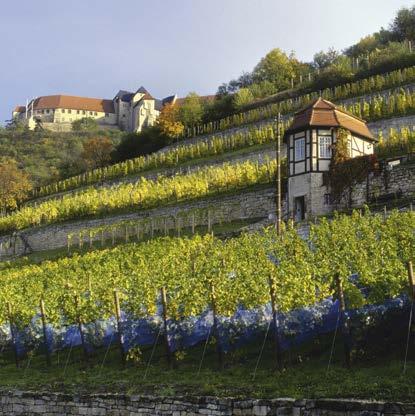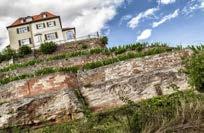
7 minute read
Saale-Unstrut
EXPERIENCE WINE IN THE MIDST OF UNSPOILED NATURE
The region derives its name from two rivers, for it is in the narrow river valleys of the Saale and the Unstrut that the majority of the terraced vineyards are located. The 51st degree of latitude runs through the region, making it Germany’s most northerly wine region in which quality wines are produced. Nevertheless, the growing season is long. The wines are delicate, yet lively, thanks to a balanced mixture of sunshine and cool temperatures. Due to the ever-present danger of frost in winter or late frost in spring, vines can only be cultivated in well-protected sites. Most vineyards face south. The pockets of warmth that develop in the river valleys make for an especially mild microclimate. With only about 500 mm of precipitation annually, the region numbers among the driest in Germany. The sun shines approximately 1,600 hours per year. Average yields are only 50 hl/ha.
Advertisement
Much of the landscape has remained unchanged for years: meadows of scattered, tall fruit trees and floodplains are interspersed among steep terraces built on centuries-old dry walls and vintners’ huts. High above are defiant fortresses and palaces. Culture and history, nature, romanticism and wine seamlessly bind with one another throughout the region. The vineyards lend the fluvial landscape its unmistakable character – and have done so for more than a thousand years. The first documented mention of viticulture along the Saale and Unstrut rivers dates from 998. In addition to the Saale-Unstrut wine road, there are two other tourist routes that run through the region: “Strasse der romanik” (romanesque road) and “Himmelswege” (Sky Paths). Castles, such as Neuenburg or rudesburg, or important buildings, such as Naumburg cathedral, as well as mystic sites, such as where the “sky disk of Nebra” was unearthed – all are inherent to the area’s cultural history. Freyburg/Unstrut is regarded as the “secret” wine capital of the region, and site of the region’s largest wine festival (second weekend of September).
There is a well-developed network of cycling and hiking trails, as well as waterways, to help visitors discover the region, its wines and wine estates, and wine pubs – and have fun doing so. The majority of the wine region is located within the Saale-Unstrut-Triasland Nature Park.


SAALE-UNSTRUT – AT A GLANCE
Geographical location: Situated on the 51st degree Traditionally, the region is known for its dry wines with 770 ha (1,925 acres) of vines, Saale-Unstrut numbers among the smaller wine regions of Germany. The majority of vineyards are located in southern Sachsen-Anhalt, with a few acres in Thüringen and Brandenburg. There’s a diverse selection of wines to sample and compare. Nearly thirty different grape varieties are being cultivated. Müller-Thurgau is the main variety, and thanks to low yields, the wines have an astonishing (Pinot Blanc) wines. The traditional white wine grapes
of latitude, in the valleys of the Saale and Unstrut rivers · Climate: Average annual temperature of 9.1°C (48.4°F), low precipitation (500 mm [19.5 in] per year), and an average of 1,600 sun hours annually · Soils: Shell-limestone, red sandstone, loess-loam, copper slate · Size: ca. 770 ha (1,925 acres) · Grape varieties: Müller-Thurgau, weissburgunder (Pinot Blanc), riesling, Silvaner, dornfelder,
a fine, subtle fruitiness and lively crispness. with only
elegance. wine-growers from the Saale and Unstrut are particularly proud of their weissburgunder Grauburgunder (Pinot Gris) Silvaner and riesling are also grown here. one fourth of the region’s vineyard area is planted with red wine grapes, such as Portugieser, dornfelder, Spätburgunder (Pinot Noir) and Zweigelt. These are true rarities that are usually quickly sold out.
Information: Weinbauverband Saale-Unstrut Querfurter Straße 10 06632 Freyburg Tel. +49 (0)34464 26110 Fax +49 (0)34464 29416 www.natuerlich-saale-unstrut.de info@weinbauverband-saale-unstrut.de
Saale-Unstrut: Landmarks of German Wine Culture
SEKTKELLEREI ROTKÄPPCHEN, SAALE-UNSTRUT
Once upon a time (1856) there were two brothers who decided to found a wine store with a mutual friend... and thus began the fantastical success story of Sektkellerei Rotkäppchen in Freyburg an der Unstrut. At the time the company was known as Kloss & Foerster. They soon dedicated themselves not just to selling wine, but also to “producing sparkling wine.” The first 6000 bottles were filled in a back-courtyard apartment, and the first sparkling wine cork popped in 1858 at the wedding of company co-founder Julius Kloss.
A Sparkling Success The company grew rapidly, and the wines from this northernmost German winegrowing region were soon sold out. By 1867 the company was forced to meet demand by buying in grapes from other regions of Germany, to be produced as sparkling wine on the Unstrut river. The winery was renamed Sektkellerei rotkäppchen in 1895. It proved itself tenacious, surviving two world wars and a period as a model company within east Germany, producing odd creations such as caffeinated sparkling wine (“Mocca-Perle”) and even “Sekt-Pils für den Mann,” a mix of sparkling wine and beer. The heart of the company was and remains the imposing winery buildings from 1897, including five storeys of cellars where the wines mature in oak barrels before being blended and filled. The winery also proudly displays the largest cuvée barrel in Germany, featuring impressive hand-carved ornamentation. The massive vessel was built using the wood from 25 separate barrels in the company's own cooperage and put into operation in 1896. Capable of holding up to 120,000 liters of liquid, it stands three stories high in the company's gigantic vault.
Rotkäppchen-Mumm Sektkellereien Freyburg an der Unstrut, Sektkellereistraße 5 Tel. +49 (0)34464 340 www.rotkaeppchen.de
THE VINEYARD HUTS ALONG THE SAALE AND UNSTRUT, SAALE-UNSTRUT

One of the most famous hallmarks of the Saale-Unstrut winegrowing region are the many vineyard huts visible on the hillside vineyards and steep terraces of the riverbank. Most are no more than small utility sheds formerly used by winegrowers to store their tools, eat a meal or take shelter against the wind and rain of a harsh day; others also served as cozy weekend houses – and a few as luxurious summer residences for celebrating winedrenched debauchery. Southern Flair in the Northernmost Wine Region Few other German winegrowing regions boast as many vineyard huts as the steep riverside vineyards of Saale and Unstrut – perhaps because there was never an official re-allocation of the plots to merge the small vineyard parcels into larger sites. In other regions, that painful process often led to the destruction of huts and sheds along with the old vines. There are as many as ten vineyard terraces on the Schweigenberg near Freyburg, yet this mere 25 hectares (62 acres) of vines features an astounding 90 vineyard huts. The most famous of these is perhaps the Toskanaschlösschen (Tuscany Manor) with its brick-red stucco and white window panes and moldings; from its look-out tower visitors enjoy a fantastic view over the vineyards of the Schweigenberg, including its old stone walls and countless stairs – as well as the Unstrut Valley.
Weinbauverband Saale-Unstrut Freyburg an der Unstrut, Querfurter Straße 10 Tel. +49 (0)34464 26110 www.weinbauverband-saale-unstrut.de
THE „STONE PICTURE BOOK“ NEAR NAUMBURG, SAALE-UNSTRUT
The Markgrafenberg bei Großjena stands at the junction of the Unstrut and Saale rivers, near the gates to the city of Naumburg. It was here that Naumburg Court Jeweler Johann Christian Steinauer acquired a vineyard in 1705, and built a stately villa above it. He commissioned a cycle of scenes to be carved into the cliff walls at the foot of the vineyard, dedicated to Duke Christian zu Sachsen-Weißenfels on the tenth anniversary of his ascension to power.

The name of the sculptor has been lost to history, but his work is known as the Steinerne Bilderbuch (Stone Picture Book). Twelve life-sized reliefs are presented in the colored sandstone, including the feudal lord proudly atop his horse. The remaining images show wine-related example shows a barefooted Jesus stamping grapes in a wine vat, while winemakers bring more grapes in traditional wooden holders carried on their backs. The next image shows Noah with a long wavy beard and flowing jacket as the first winemaker; in one hand he holds a vine, in the other a vintner's knife. Naturally Steinauer also had himself immortalized in the image cycle, if only
To Our Gentle and Benevolent Ruler scenes from the old and New Testament. one relief for in the dedication from 17 March 1722. Tourist-Information Naumburg, Markt 12 Tel. +49 (0)3445 273125 www.naumburg.de










